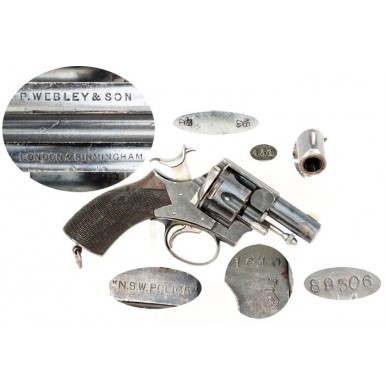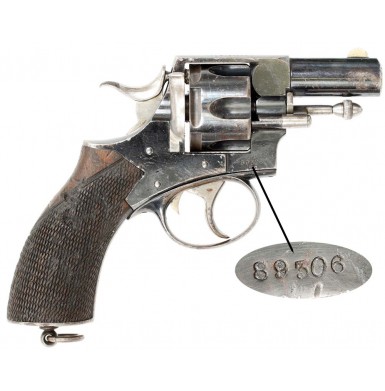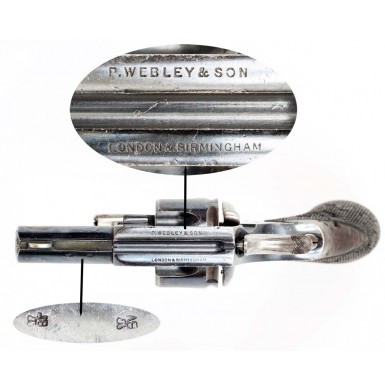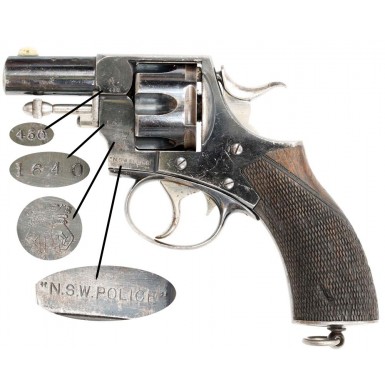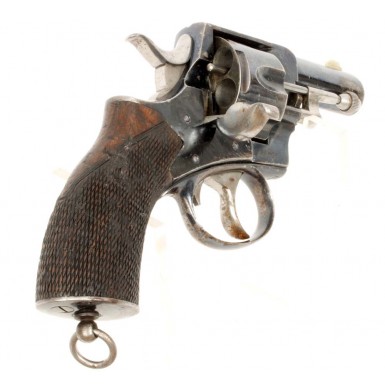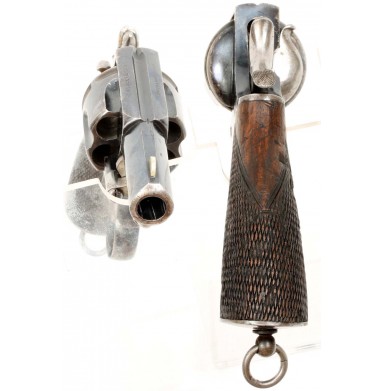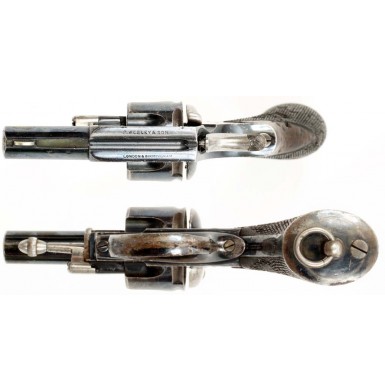New South Wales Police Marked Webley R.I.C.
- Product Code: FHG-1829-SOLD
- Availability: Out Of Stock
-
$1.00
Brothers James and Philip Webley together would start what would become the most successful revolver companies to be established in England. James, the elder Webley, was born in 1807 and established himself in the trade by the time that his younger brother Philip (born in 1813) was done with his apprenticeship as a gunmaker. Both Webleys initially worked as gunlock filers and gunlock makers, as well as “percussioners”, and by the mid-1830s they were working together in that capacity on Weaman Street in Birmingham. James Webley was also working on producing his own complete firearms to sell under his own name, and by 1835 had a retail outlet at 14 St. Mary’s Row in St. Mary’s Square. In 1838 young Philip “acquired” the gun implement making company of William Davis by marriage to his daughter Caroline. Davis, a noted bullet mold and implement maker had passed away in 1831 and his wife Sarah and his daughter Caroline had continued to run the business until Philip married into the family. From that point, the Webley story centered on the old Davis business location at 84 Weaman Street, and would eventually expand to include #81-#91 Weaman Street. By 1845, at the age of 32, Philip was in a position to purchase the business from Davis’ widow. By the early 1850s the Webley brothers were producing, both alone and in joint venture, a variety of small arms including single shot percussion pistols, various repeating pistols such as pepperboxes, “transitional” pistols and early single and double action revolver designs, as well as “ships pistols”, muskets and various long arms. Their customer list included the two largest and most important gun buyers of the era in England, the Honorable Board of Ordnance (the British Military) and the Honorable East India Company; whose private army protected the company’s investments around the world, and was one of the largest and best-equipped military forces of the time. In 1853 the genesis of what would be the most lucrative part of the Webley business going forward occurred; James Webley’s design patents were filed for what would become known as the Webley “Long Spur”. The patent was number 743, granted March 29, 1853, for a new single action revolver design. The revolver was a percussion ignition handgun with a unique grip angle and a long, low, extended hammer spur that made the cocking of the action very fast. The “Long Spur” was a handcrafted elegant piece, which was exceptionally well made within the limitations of the small format business of the time. However, the quality that went along with master craftsmen building the guns by hand meant two things; the interchangeability of parts was limited at best and the guns tended to be expensive. As a result, the Webleys had a hard time competing with their biggest rival in single action revolvers, Samuel Colt. Colt had established his manufactory in London in 1851 after The Great Exhibition, and the Webleys could not compete with the Colt product on the basis of price, as the Colt revolvers were manufactured on the basis of interchangeable parts with an assembly line system. This motivated Philip in particular to pursue both theories of modern production and put significant effort and monies into the building of interchangeable parts guns in an assembly line fashion. In 1856 James Webley died, and Philip was left to lead the company going forward. The following year Colt closed his London manufactory and put Philip Webley in the unique position of being able to fill the void left by the closing of the Colt plant. Webley had himself taken out two revolver patents in 1853 (#305 on February 4th and #2127 on September 14) for “improvements to revolver lock mechanisms’ and these patents would form the basis for his famous “Wedge Frame” revolver that would help establish Webley as a premier maker of English double-action handguns. In 1860 Webley’s two sons Thomas and Henry joined the company and it was renamed P. Webley & Son, with locations in Birmingham and London. Over the next few decades, Webley would become the premier English revolver maker with a wide variety of revolver designs as well as a line of semi-automatic handguns that were introduced after the turn of the century. In 1877 the firm began to absorb large, old time Birmingham makers with the acquisition of Tipping & Lawden. In 1897 they acquired Richard Ellis & Company and the long time firm W. & C. Scott. At that time, the firm changed their name to The Webley & Scott Revolver & Arms Company. It was with the introduction of their first double action, centerfire metallic cartridge revolver designs in the latter part of the 1860s that the Webley firm really came into its own. The Webley firm had previously produced both pinfire and rimfire cartridge revolvers, but it was the centerfire cartridge that brought reliable, reloadable stopping power to their handgun designs. Initially the firm offered “dual ignition” revolvers with both a center fire and a percussion cylinder, allowing the user to switch to percussion if cartridges were not readily available. However, in 1867, they introduced a double action, center fire, solid frame revolver that would become known as the Royal Irish Constabulary model (R.I.C.). These revolvers were made available in a variety of calibers and barrel lengths, and derived their name from being adopted by the newly established Royal Irish Constabulary in 1868. The gun initially had no model or year designation, and was known simply as the Royal Irish Constabulary model, however as improvements were made in the design a system of separating the models had to be developed. Although it is unclear if the Webley’s used this system, for all practical purposes these earliest R.I.C. guns are Model 1867 revolvers. Their initial offering was in .442 Mark I (the same size as 54 bore from the old percussion days), but eventually the model would be offered in .450, .476/.455, .455/.450, and .430 as well as the American calibers of .44 WCF (.44-40) and .45 Colt. The guns had six shot “plain” cylinders, without flutes, that were loaded through a hinged gate in the right side of the frame. Empty cartridges were ejected via a swiveling ejector rod that was stored in the hollow center of the cylinder arbor pin. Typical barrel lengths varied from about 2 ““ to 4 ““ in length, and were initially rifled with 5 narrow grooves with a 1:15 right hand twist. The fact the guns were so successful with the new Irish police force resulted in other Commonwealth police agencies acquiring the guns as well. The R.I.C. model was adopted by the London police force, as well as many other English and Australian state police forces as well. The model proved equally popular throughout the British Empire. To capitalize upon the revolver’s popularity with police, Webley released an updated version of the gun in 1880, the Model 1880 R.I.C. and Metropolitan and County Police No 1. This gun had an improved lock work and ejector system, and was made with a 2 ““ barrel to aid in concealment. The English policy of the time was for most “metropolitan” or city police to be unarmed and those in rural areas to be armed with long guns as needed. Handguns were typically restricted to special officers, sergeants and command officials and rural constables. However, the preference was for the officers who carried handguns to carry them concealed, thus the snub-nosed, 2 ““ barrel configuration. The guns were chambered for the .450 Boxer (also known as .450 Adams) cartridge. It fired a 225 grain round nosed bullet with a charge of 13 grains of black powder, at about 650 feet per second, generating slightly more than 200 foot-pounds of energy. This is about the same amount of power generated by other contemporary cartridges like the .38 Smith & Wesson, .44 American and .41 Long Colt. To further capitalize upon the “Police” use and designation, the firm stamped the lefts side of the frame, forward of the cylinder, with a pair manacled hands, over the initials M.P. for “Metropolitan Police”. Those revolvers taken into service with police forces were typically marked with a police inventory number and in the case of some departments, additional identifiers. In 1883, Webley introduced another improved version of the R.I.C., the Model 1883 or Webley’s R.I.C. New Model No 1. This was the first of the R.I.C. series to have a fluted cylinder. The gun also included further refinements to the lock work and the ejector rod system. This model was officially adopted by the London police department and numerous “Metropolitan Police” versions of the New Model No 1 were sold in .450 with 2 ““ barrels to Commonwealth police forces around the globe. Even though the gun had a short barrel, it was incredibly accurate. In fact, a May 21, 1884 article in the Birmingham Daily Mail recorded the following story of Henry Webley’s shooting prowess with a Metropolitan Police Model:
“In demonstrating to his police pupils the manner in which the revolver ought to be used, Mr. Webley fired five shots at nine yards at a target having a bull’s eye 2” in diameter. The result was that the bullet’s lodged in a space 2 ““ by 1 “. Then the range was increased to 15 yards and five shots were fired at a similar target - the bullets in this case being put into a space of 2 ““ by 1 “. The next move was made to a distance of 25 yards from the target and at this range five shots were fired by Mr. Webley. The same undeviating accuracy was maintained “ a surface of 2 ““ by 3 ““ was riddled. Having witnessed the expertness of their instructor, the police sergeants had a little practice themselves and soon satisfied Mr. Webley of their ability to make use of their weapons at long and short distances.”
Two things immediately stand out in this story: #1 “ Henry Webley was one heck of a good shot! #2 “ Only the London police sergeants, not the average patrolmen, were being trained to use the revolvers. Based upon the above account, it seems quite possible that the various shooting feats that Arthur Conan Doyle attributed to his character Sherlock Holmes (who carried a Webley Metropolitan Police revolver), were quite possible! The quality, durability and accuracy of the R.I.C. design meant that many of their Metropolitan Police revolvers remained in use well into the 20th century, and in some cases were not sold out of service until the 1950s!
Offered here is a VERY FINE condition example of a Webley 1883 R.I.C. New Model No 1 “Metropolitan Police” Revolver that is marked to the New South Wales police force in Australia. This is likely one of the guns that was sold as surplus by the force in 1953. As revolvers saw limited use by the rank and file and were typically only issued to sergeants, detectives and special division officers, finding any Australian police marked R.I.C. in somewhat uncommon. The topstrap of the revolver is clearly marked: P. WEBLEY & SON on one side and LONDON & BIRMINGHAM on the other. The left side of the frame is marked with the manacled hands logo with WEBLEY’s above it and M P below it. The ownership mark “N.S.W. POLICE” is present below the logo and New South Wales police inventory number 1640 is above the logo. The right side of the frame is marked with the serial number 89306. The bottom of the barrel (concealed by the cylinder arbor pin) is marked with the last two digits of the serial number 06 and inside lip of the loading gate and the cylinder arbor pin are both marked with the last number, 6. The left side of the barrel to frame juncture is marked .450. The gun is 100% original and correct in every way. The gun retains about 75%+ of its original bright blued finish overall, some of which has faded, thinned, dulled and worn. The gun shows fading and wear from carry along the sharp edges, at the muzzle, the topstrap and a few places on the frame. A thumb sized areas of finish is missing from the right side of the barrel near the muzzle, and there is some finish loss on the left side of the frame where “N.S.W. Police” is stamped. There is also some finish loss on the butt cap where the lanyard ring has worn away the blue. The triggerguard and gripstrap show significant loss of blue due to carry and wear. The gun is smooth with no pitting present but it does show some lightly scattered flecks of pinpricking around the muzzle, and on the frame forward of the cylinder. There are also some lightly scattered flecks of minor surface oxidation present forward of the cylinder chamber mouths and on the barrel. A pair of Birmingham commercial proof marks are present on the left upper angled barrel flat. The cylinder also bears the usual Birmingham commercial proof marks at the rear of each flute. The hammer, trigger, loading gate and ejector rod are correctly finished in the white and retain the large majority of their original polish. Both the trigger and interior of the triggerguard show some scattered flecks of minor surface oxidation. The revolver is mechanically EXCELLENT and functions perfectly in every way. The revolver times and indexes correctly and locks up quite tightly. The action functions crisply in both single and double action modes, and the loading gate closes tightly and securely as it should. The bore of the revolver rates VERY FINE and remains mostly bright with very crisp 6-groove Metford patent rifling its entire length. The bore shows only a few patches of lightly scattered pitting along its length and some light frosting in the narrow grooves. The original lanyard ring is in place in the butt of the revolver and moves smoothly and easily. The original half-moon, German silver front sight is in place on the top of the barrel near the muzzle and is in fine condition. The one-piece checkered walnut grip remains in VERY GOOD condition. The grip is solid and complete and free of any breaks, cracks or repairs. The checkering shows some minor wear and flattening to some of the points, and also shows the bumps, dings and minor mars typical of police used revolver that was primarily carried concealed.
Overall this is a really wonderful example of a very desirable late 19th century Webley 1883 R.I.C. New Model No 1 “Metropolitan Police” Revolver in VERY FINE condition. These workhorse revolvers did yeoman’s duty with the Commonwealth police forces of the late 19th century and saw use well into the 20th. These ubiquitous handguns made them the perfect choice for the revolver carried by Conan Doyle’s Sherlock Holmes, and they are certainly a classic and historical law enforcement weapon. Any “Metropolitan Police” revolver that actually bears police markings is a scarce and desirable gun, and it is certainly difficult to find them in this condition, as constant concealed carry tended to be hard on the finish. This is wonderful example of a very scarce and desirable New South Wales police marked Model 1883 R.I.C. New Model No 1 Metropolitan Police revolver that you will certainly be very proud to own and display and to add to your collection of fine 19th century revolvers.
SOLD
